|
When you just
want to get out of the elements for a little while, one of these may
be the answer, they provide minimal protection and could never be
described as comfortable, but they may make the difference between
life and death if you are too tired or injured to construct anything
more elaborate.
Bough Shelter Look
for branches that sweep to the ground or fallen boughs that offer
protection from the wind-ensure they are secure enough not to fall
on you though! You may want to secure them by lashing (see diagram).
Weave in other branches to add supplemental protection, conifers are
more suited to this technique than broad leaves.
![[IMAGE]](BOUGH.GIF)
Root Shelter
The spreading roots and compacted earth at the base of a fallen
tree form a useful storm barrier, if they are facing the right
way. Filling in the sides around the roots will increase it's
potential and provide a solid base for construction of something
more elaborate.
Natural Hollow
A shallow depression in the earth will provide some protection
from wind immediately, and provides a natural basis for construction
of a shelter. However care must be taken in damp areas or on hills
or you'll end up under water! Lay a few light logs across the
hollow and then a larger bow across them, this will give pitch
to short branches laid across the top to keep out rain. Finish
with turf or twigs and leaves.
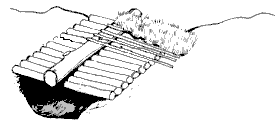
-
Fallen Trunk
A fallen trunk alone provides a good windbreak scoop out a small
hollow on the leeward side and construct a lean-to roof of boughs.

-
Stone Barriers
A shelter is more comfortable if you have enough headroom to sit
up in it. So build up a low wall of stones around a hollow or
shallow excavation. Caulk the walls with mud, leaves, twigs and
turf, finish with a roof of branches and turf.
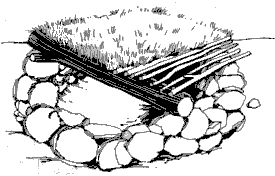
-
Sapling Shelter
If you should happen upon a growth of saplings, clear the ground
between them and lash their tops together, weave branches between
them and consolidate with ferns and turf. A similar effect can
be gained by driving pliable branches firmly in the ground.
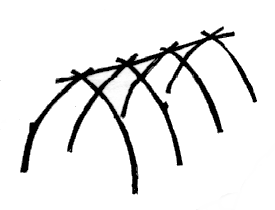
If you have your "bug-out" or emergency
kit you should have access to some form of waterproof sheeting,
throw this over the saplings and weight with stones or logs
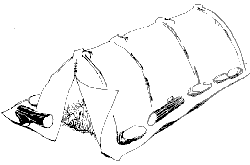
Bashas With
a waterproof poncho, groundsheet, piece of tarpaulin or plastic
sheeting you can construct what is often referred to in the forces
as a "basha". There are a few designs below. Remember,
always use natural shelter where possible, always insulate yourself
from the ground and always secure the sheeting carefully.

-
Tepees Best
known as the homes of North American Indians, start by tying three
or more uprights together to form a cone, you can tie them on
the ground before erecting. Cover with hides, sheeting or panels
of birch bark. Ensure you leave a hole at the top for ventilation.
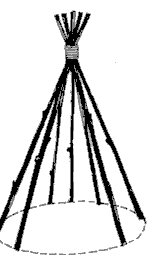
Snow Cave
Under conditions of heavy snow it may be impossible to find building
materials, at least not quickly enough to get you out of the elements.
Fortunately snow itself provides a good building material. Dig
into a drift of firm snow to make a "cave" Make use
of the fact that warm air rises and cold air sinks. Make your
shelter on 3 levels. Build a SMALL fire on the highest, sleep
in the middle and allow the low area to trap cold air. Use a stick
or ice axe to force two holes in the roof, one to allow smoke
to escape another to provide ventilation, fit a packed block of
snow to the door.
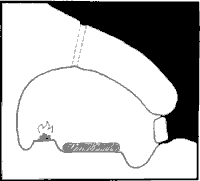
Stick Walls & Screens
It is possible to build simple walls by piling sticks between
uprights driven into the ground and (if possible) tied at the
top. Fill them well with dirt to close gaps and keep out the elements.
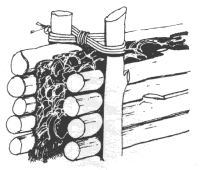 build build
Coverings Make wattle
and woven coverings for roofs or walls from springy saplings,
small branches, plant stems, grasses or long leaves. First make
a frame from less pliable material, tie off the struts and then
weave in your materials. If you have little cordage drive the
uprights into the ground and weave in enough of your material
to make a basic framework, remove from the ground and finish.
![[IMAGE]](COV1.GIF)
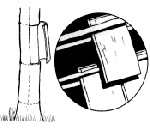
Caves provide ready
made shelter, even small caves can be made habitable and the larger
ones make ideal permanent homes. Caves in rock set above valleys
are normally dry inside, even if you get a little seepage through
the roof. Caves can be cold and sometimes the local fauna may
have beaten you to it so approach with care, if there are signs
of other "inhabitants" light a fire near the entrance,
but be sure to allow them an escape route, a good insulating layer
of dry plant matter should help deal with the other problem. Beware
of rock fall !!! getting permanently trapped in your new home
is not conducive to personal survival.
If the cave faces into wind put up two screens
outside, one on each side, overlapping to provide an entrance.
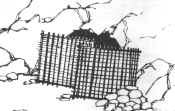
Fires should be
kept towards the rear of a cave, the smoke will rise and follow
the roof to an exit, smoke from a fire lit near the entrance on
the other hand will blow inside.
Sod House
Turf Houses are useful
in areas where timber is scarce or you do not have the necessary
tools to work in wood. Cut sections of turf 18x6in and build them
like bricks, overlapping "Old English" fashion. slope
the walls towards the rear to give pitch to your roof, which will
have to be supported by wooden spars or some other equally strong
material. Make a cover as described above and attach to the spars,
cover this with leaves and the a layer of turf. Build low, big
enough to sit up or maybe scuttle around in but not high enough
to stand up straight. You can leave the leeward side open, or
for a stronger build fit a doorway to the lee wall, for this however
you will need timber for the frame. You can build in an internal
hearth and chimney, but remember that turf is flammable, coat
the hearth area thickly with clay before use, or light a fire
outside the door with a fire reflector behind.
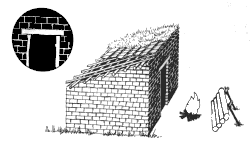
Log Cabins: The size
of your log cabin will depend on two factors, the size of your
timber and the number of people it is to house. A square or rectangle
shape will be easiest to build and roof, 8ft square is a sensible
size for a small cabin.
Choose a level site to build your cabin, flatten
a larger area if necessary, the walls must be level. Cutting down
logs should ideally be accomplished with an axe or 2 handed saw
although in a pinch the flexible saw from a survival kit will
suffice. Unless you're sure you're up to the job don't attempt
windows, you should get enough ventilation from the doorway, don't
worry about making a door immediately, hang a blanket or other
cloth over the door, it'll keep out the wind. Caulk between the
logs with a mixture of mud and the wood chips from your logging,
use a sharpened stick to force it into the gaps. Cover the roof
with saplings before laying a layer of mud and turf. You can add
a fireplace if you leave a space in the roof for smoke to escape,
but never leave it unattended, put it out rather than risk a fire,
if you do make a fireplace it may be worth using stone if you
have a ready supply, make a fireplace and chimney from flat sided
rocks caulked with clay.
|
